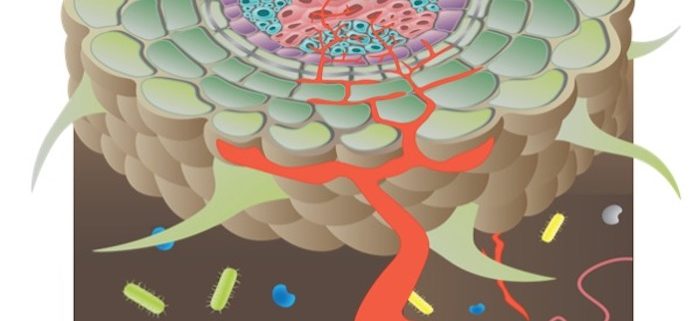Fungal Proteins for Invading Multiple Plants
By Amey Redkar1 and Antonio Di Pietro2. Illustration by Dr. Lindsay Erndwein
1Department of Botany, Savitribai Phule Pune University, Ganeshkhind, Pune 411007, India
2Departmento de Genetica, Universidad de Córdoba, 14071, Córdoba, Spain
Background: Most interactions between plants and microbes occur belowground. The soil-inhabiting fungus Fusarium oxysporum (Fo) can enter the roots and colonize the water-transporting vessels of its host plant, causing wilt disease that provokes devastating losses in hundreds of different crops worldwide. Although any given strain of Fo only induces wilting on a few plant species, such strains can still colonize the outer root layers of other plants without causing visible disease symptoms. Indeed, asymptomatic root colonization can even protect plants against infection by pathogenic strains. How Fo has acquired the capacity for multi-host root colonization remains largely unknown.
Question: Initial colonization by Fo occurs predominantly through filaments called hyphae, which grow in the space between the plant cells known as the apoplast. We reasoned that the fungus must release molecules into the apoplastic space that promote its establishment in the root and used discovery proteomics to test this idea.
Findings: We found a set of previously uncharacterized proteins that we called Early Root Colonization (ERC) effectors and showed that they contribute to fungal growth on diverse species of plants ranging from cultivated tomatoes to an evolutionarily distant non-vascular plant called Marchantia polymorpha. Intriguingly, the ERC proteins identified in our work are predicted to bind or modify the molecules that make up the plant cell wall and are found across a wide range of fungal lineages. This suggests that the cell wall is a major target for fungi establishing either detrimental or beneficial associations with plants.
Next steps: The discovery of a set of ERC proteins sheds new light on how root-colonizing fungi are able to infect a broad range of plant hosts. Future studies should aim to identify the plant mechanisms targeted by these effectors and use this knowledge to protect crops from the harmful effects of fungal pathogens.
Amey Redkar, Mugdha Sabale, Christian Schudoma, Bernd Zechmann, Yogesh K. Gupta, Manuel S. López-Berges, Giovanni Venturini Selena Gimenez-Ibanez, David Turrà, Roberto Solano, and Antonio Di Pietro (2022). Conserved Secreted Effectors contribute to Endophytic Growth and Multi-Host Plant Compatibility in a Vascular Wilt Fungus. https://doi.org/10.1093/plcell/koac174




